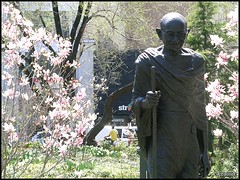Nonviolence is the greatest force at the disposal of mankind. It is mightier than the mightiest weapon of destruction devised by the ingenuity of man.
-- Mahatma Gandhi
Literally speaking, ahimsa means non-violence towards life but it has much higher meaning. In its comprehensive meaning, ahimsa or non-injury means complete abstinence from causing any pain or harm to another living being, either by thought, word, or deed. Non-injury requires a harmless mind, mouth, and hand.
One of the tenets of Karmacology is, "First, do no harm." This is the initial consideration towards right action, and fits nicely with the concept of ahimsa.
Ahimsa is the first of the five Yamas, or abstentions, taught as part of the Eight Limbs of Yoga in the classic Yoga Sutras. It is, however, more than just "lack of violence" as taught in the sutras. It means kindness, friendliness, and thoughtful consideration of other people and things. It also has to do with our duties and responsibilities. Ahimsa implies that in every situation we should adopt a considerate attitude and do no harm.
So how does a martial artist reconcile the paradox between the conflict of combat and the teachings of nonviolence? My path has led me to Aikido, a martial art that embodies the principles of nonviolence and nonresistance in both philosophy and practice. One insight from my own training is that Aikido's non-violence is not a way of avoiding violence, but is rather a way of transcending violence.
As explained by the founder, O Sensei:
Aikido is nonviolence. Every human being has been entrusted with a mandate from heaven, and the victory we seek is to overcome all challenges and fight to the finish, accomplishing our goals. In Aikido we never attack. If you want to strike first, to gain advantage over someone, that is proof your training is insufficient, and it is really you yourself who has been defeated. Let your partner attack, and use his aggression against him. Do not cower from an attack; control it before it begins. Nonviolence is the true practice of Aikido.
-- Morihei Ueshiba
Aikidoists do not initiate attacks, or try to win fights or defeat opponents. Instead, their goal is to control and neutralize an attack through circular and spiral motions that blend with the energy of an attack and redirect that energy back against the attacker.
Instead of directly blocking or controlling an attack, the techniques of Aikido are designed to harmonize with the power and direction of the attack and convert it into a force that will unbalance the attacker and render him helpless. Attacks are then neutralized by the use of various anatomical locks and pins, rather than crippling kicks or blows.
A final thought on this concept of non-violence is that it must be a conscious choice, not the only remaining option, borne of helplessness. Gandhi expressed this idea as, "It is better to be violent ... than to put on the cloak of nonviolence to cover impotence."
Aikido sensei Yukiyoshi Takamura had another perspective on this same idea:
A pacifist is not really a pacifist if he is unable to make a choice between violence and non-violence. A true pacifist is able to kill or maim in the blink of an eye, but at the moment of impending destruction of the enemy he chooses non-violence. He chooses peace. He must be able to make a choice. He must have the genuine ability to destroy his enemy and then choose not to. I have heard this excuse made. “I choose to be a pacifist before learning techniques so I do not need to learn the power of destruction.” This shows no comprehension of the mind of the true warrior. This is just a rationalization to cover the fear of injury or hard training.
The true warrior who chooses to be a pacifist is willing to stand and die for his principles. Only a warrior who has tempered his spirit in conflict and who has confronted himself and his greatest fears can, in my opinion, make the choice to be a true pacifist.
